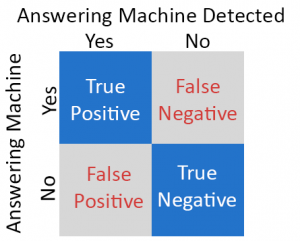
Have you ever called someone and hear them begin to speak “Hello,” followed by a disappointing “Sorry I’m unable to take your call right now. Please leave a message and I will…?” Of course you have. You get an answering machine for two reasons: the person can’t pick up or the person doesn’t want to pick up. Either way, hopefully the message you leave on their voicemail is something along the lines of “This was a waste of my time, and I’ll never get the last thirty seconds of my life back. Thanks, hear from you soon!” But, that’s not exactly recommended. Obviously you should be tasteful if you’re serious about having your call returned. However, you could opt to skip the answering machine experience almost entirely if you have a tool that somehow detects you aren’t reaching a live person when you call.
AMD Technology
Answering Machine Detection (AMD) is a technology included in dialers meant to screen out calls that get sent to voicemail inboxes. It detects whether or not there is a live call based on 3 main principles:
- Background noise associated with a pre-recorded message
- Long strings of words such as “Hello, I am sorry I missed your call. Please leave a message…”
- A live caller saying something similar to “Hello, hello?” followed by a post-greeting silence
 With 40% to 60% of calls to consumers going to voicemail, in theory AMD is an excellent idea. It should eliminate the number of voicemail inboxes over live calls your agents receive but the technology is not perfect. A few issues are:
With 40% to 60% of calls to consumers going to voicemail, in theory AMD is an excellent idea. It should eliminate the number of voicemail inboxes over live calls your agents receive but the technology is not perfect. A few issues are:
- The voicemail is not a long string of words or includes a pause, confusing the system into thinking it’s a live caller (also known as a false negative)
- There is a small delay while the system connects the call to an agent, which could result in the receiver of the call possibly hanging up
- The dialer incorrectly guesses a live call as a voicemail and hangs up (also known as a false positive)
- The number is a PBX (private branch exchange) with multiple levels of voicemail prompts
AMD and Abandoned Call Rate
Last time I checked, answering machine detection is a thing, and things don’t get hungry, do they? Well, you should be aware that AMD’s inaccuracy can eat into the abandoned call rate permitted by the FTC. Therefore, it is important to decide on whether or not AMD is the correct option for your call center. If you decide to leave AMD on, keep track of your AMD accuracy to determine whether or not it’s viable. A high AMD accuracy should be your goal. To determine AMD accuracy use this equation:
AD = Calls disposed by Agents as AMD
CC = Total Connected Calls
AMD Accuracy(%) = (1 – (AD/CC))%
EVS7’s Parrot Cloud Call Center gives you 4 options to consider for AMD:
AMD on and leaving automatic voicemails
Pros: Agents primarily interact with live calls 95% of the time, maximizing talk time. Can leave automatic voicemails if an inbox is detected.
Cons: The industry technology leaves a voicemail 50% to 60% of the time due to false positives because there is such a large variety of types of answering machines. Can irritate customers because it adds a short delay to live calls.
Best uses: Calling consumers during the day when you may get a large quantity of voicemails and it’s not urgent to ensure every lead receives a voicemail.
AMD on but not leaving any automatic voicemails
Pros: Agents primarily interact with live calls 95% of the time, maximizing talk time.
Cons: Can not leave any voicemails. Adds a delay to live calls which can annoy customers.
Best uses: Calling consumers during the day when you may get a large quantity of voicemails and you don’t want to leave any voicemails.
AMD off – agents can leave a manual voicemails
Pros: Voicemails can be left 100% of the time.
Cons: Agents must determine whether they are receiving a live call or voicemail. Must manually leave a voicemail. Most time consuming and can lower the number of calls your agents make in a day.
Best uses: Calling consumers or businesses and leaving customized voicemails.
AMD off – agents can leave a prerecorded voicemail
Pros: Agents can leave a personalized, pre-recorded voicemail 100% of the time saving significant time by avoiding repeating the same message over and over.
Cons: Agents must determine whether they are receiving a live call or voicemail. More time consuming than AMD but quicker than manually leaving a voicemail.
Best uses: Calling consumers or businesses and leaving generic voicemails.
Voicemail Tips
Whether you to turn Answering Machine Detection on or off, if you want to leave a voicemail message, here are a few tips:
Keep it under 20 seconds.
People have a short attention span. They would also rather be doing something else than listen to their phone playback a string of messages. Step into your customers shoes. Enough said.
Be humorous.
Not all of us can be comedic like Richard Pryor or Louie CK, but if you can tickle a person’s funny bone, they will automatically like you or at the very least see you in a positive light. This tactic can actually be used in many different situations, and boy, does it work like a charm!
Here’s why: If you can make a person laugh, they will want to be around you more and they will pay more attention to what you have to say. The reason is simple and is a direct result of the brain’s physiology: Laughter causes a release of endorphins and gives people a happy feeling. Naturally, people gravitate toward this emotion and if things feel natural, as a telemarketer you effectively circumvent the customer’s vexed feeling of “Oh, this is just another sales call.” When you are the source of someone’s happy feelings, you become irresistible – and as a telemarketer, that is exactly what you want to be whenever a person is listening to a voicemail you’ve left them. I highly recommend you find a business-appropriate avenue to give your customers and leads a good chuckle. It pays to be funny.
Have Order.
It’s very easy to tell when a person is trying to sell something over the phone. You hear a person’s name followed by the name of the business they represent and BOOM, the instinctive reflexes to press the “Erase Message” button kick in. As soon as other people hear this, they know it’s a sales call, too. So don’t be like your boring competition who repeats the same things in the exact same order like a metronome. Stand out by doing this: Immediately state your reason for calling, say something that will make them laugh or think, clearly speak your phone number, your name, your company’s name, and then repeat your phone number. Lastly, end your message telling them “I look forward to chatting with you,” or “Thanks, can’t wait to chat with you.” Give your script some extra thought. It can only result in establishing better business-customer relationships and put a good spotlight onto your company.
Bonus Tip:
Sound friendly and have an upbeat tone of voice. You’re not selling anything by sounding like Ben Stein (with the exception of the product Clear Eyes).
Conclusion
AMD is a great concept, but its voicemail detection still leaves a lot to be desired. For most scenarios with the Cloud Call Center, we most recommend turning AMD off and leaving prerecorded voicemails. Studies show that leaving a voicemail (a good one), will lead to increased callbacks. While agents may lose time waiting to see if they reach a live call or not, they will gain time with voicemail automation without worrying about losing leads and can expect a few callbacks.

